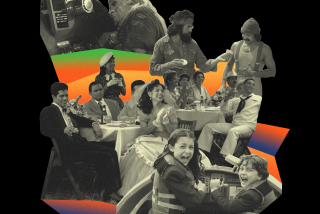From the Archives: Cantinflas, Latin America’s Beloved Comic Actor, Dies
Cantinflas, Latin America’s most celebrated and loved comic actor and the man Charlie Chaplin once called “the world’s greatest comedian,” died Tuesday of lung cancer. He was 81.
Mario Moreno Jr., the actor’s adopted son and only survivor, told reporters his father died at his Mexico City home.
Cantinflas was diagnosed earlier this year as having cancer during a checkup at a clinic in Houston, but his son said he concealed the nature of the illness at his father’s request.
Cantinflas was in intensive therapy in Mexico City for several weeks, but spent the last days in his house.
Although generations of Latinos were charmed by his garrulity in a variety of parts, he was best known to American audiences for a single role: the 1956 film “Around the World in 80 Days,” in which he portrayed Passepartout, the bumbling valet of Phileas Fogg, played by David Niven.
Cantinflas made only two films during his brief career in the United States in the late 1950s, but he starred in at least 35 films in Mexico, many for his own company, Posa Films, later known as Cantinflas Films.
It is a measure of Cantinflas’ impact upon the Spanish-speaking world that his name became recognized by linguists as a new colloquialism. Literally, Cantinflas has no meaning—the actor made up the word as a stage name. But the noun cantinflada is now defined in the authoritative Larousse Spanish dictionary as a long-winded, meaningless speech, while the verb cantinflear means to talk too much but say too little.
Cantinflas was widely loved for his character el peladito, a penniless urban slum dweller who used his wit and unfailing good luck to escape from impossible situations. Often compared to Chaplin’s “Little Tramp,” el peladito had a tiny mustache at each end of his upper lip. A tenement dweller and jack-of-all-trades, he wore a tattered vest, a straw hat and a pair of worn trousers held up by rope.
El peladito enabled Cantinflas to journey from the tents of Mexico’s traveling circuses, where he began his career in the 1930s, to international stardom and a multimillion-dollar fortune.
From the time he made his first full-length feature in 1940, his films consistently set box-office records throughout the Spanish-speaking world.
As late as 1983, his film “El Barrandero” (“The Street Cleaner”) made more money than any other Spanish-language feature ever shown in the United States.
At the peak of his career in the late ‘50s, Cantinflas was earning more than $1.5 million a year and was referred to in press releases as the world’s highest-paid comedian.
With the success of “Around the World in 80 Days,” which won five Oscars, including best picture, Cantinflas’ popularity quickly spread beyond the Spanish-speaking world.
After “Around the World,” Columbia Pictures starred Cantinflas in his own, multimillion-dollar epic, “Pepe,” which included cameo appearances by more than 35 stars, including Maurice Chevalier, Bing Crosby, Tony Curtis, Frank Sinatra and Edward G. Robinson.
“Pepe” however, failed miserably at the box office and put an end to Cantinflas’ career in the United States. He returned to Mexico, where he continued making movies well into his 70s.
The character Cantinflas portrayed on the screen reflected his upbringing in the poor, working-class neighborhoods of Mexico City, where he was born Mario Moreno on Aug. 12, 1911, during the height of the Mexican Revolution.
The son of a postal employee who was the sole breadwinner for a wife, 12 sons and three daughters, Cantinflas graduated from high school and at 15 was sent to an agricultural college. He stayed there for nine months before running away to Jalapa on the Pacific coast, where he joined a carpa, or tent show, and began his career as an actor.
It was in the tent shows that Cantinflas developed el peladito, the picturesque “wise guy” from Mexico City. In a 1957 interview, Cantinflas reflected on the birth of el peladito and the beginning of his career.
“I found out, with no little surprise, that I could give them laughter with a twitching of my mouth, with a sample of the vernacular I had picked up from my neighborhood cronies.”
In 1936 he made his first “film,” a two-reel advertisement for a trucking company. A year later, he appeared in his first movie for the nascent Mexican film industry, “Asi Es Mi Tierra” (“That’s My Country”).
He scored his first international success in 1940 with what also was his first full-length feature, “Ahi Esta el Detalle” (“There is the Detail”). The film’s high point was the final courtroom scene, in which his character flouts social and legal conventions and succeeds in so confusing the arrogant judge and attorneys that they end up speaking in confused “ Cantinflas - isms .”
The use of the irreverent, street-wise humor and the colorful, vivid language of Mexico City’s poorer neighborhoods became Cantinflas’ trademark. The actor once described himself as “a blabbermouth trying to stay afloat in a flood of words--his own words.”
Always a workingman’s comic, in his films Cantinflas used his wit to poke fun at the pretentious and the powerful.
In his second major film, “Ni Sangre, Ni Arena” (“Neither Blood Nor Sand”) Cantinflas plays dual roles—an arrogant matador and a humble, devoted fan. The comedy begins when, through a classic mix-up of identities, the lowly fan is mistaken for the vain bullfighter.
Cantinflas was to perfect the bullfight into one of his most famous routines, performed again and again in arenas in Mexico, Europe and the United States. The scene is one combining both danger and joy. When the bull paws the ground, Cantinflas paws the ground. He reads a newspaper, undaunted, as the bull rushes by. He tumbles into the charging bull’s path, and escapes somehow unharmed. His pants fall off, revealing pink, ruffled underwear, and he scampers red-faced to the nearest refuge for repairs. Finally, he plunges a mock sword over the bull’s horns and it bursts on contact into a brilliant bouquet of flowers.
The money Cantinflas earned from these early endeavors was invested in numerous business ventures, including two film companies, office buildings and a 2,000-acre bull-breeding ranch on the Mexico City-Guadalajara highway.
He lived in a luxurious home in the exclusive Lomas de Chapultepec area of Mexico City, and also had a residence in Century City.
Cantinflas was married once, to Valentina Moreno, a Russian actress he met in his tent show days, and they had one child, Mario Antonio. Cantinflas never remarried after his wife died in 1966.
As he grew wealthier, Cantinflas became known as a great philanthropist, and it was said he donated half of his earnings to charity.
Throughout his career, he expressed a deep love for the Mexican people.
“My character is part of this country,” he said in a 1948 interview.
“Cantinflas represents the humble Mexican who wants to overcome himself and accomplish something in life. This is the message of the films.”
From the Archives: Debonair Actor Joseph Cotten Dies at 88
From the Archives: Consummate Entertainer Sammy Davis Jr. Dies at 64
From the Archives: Bette Davis Dies in Paris at 81
From the Archives: Elizabeth Montgomery Dies of Cancer
From the Archives: Jack Lemmon, Everyman Star, Dies
More to Read
Start your day right
Sign up for Essential California for the L.A. Times biggest news, features and recommendations in your inbox six days a week.
You may occasionally receive promotional content from the Los Angeles Times.







